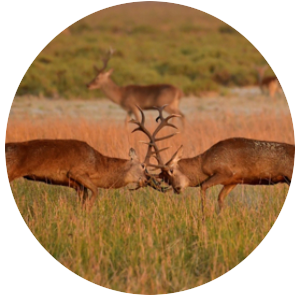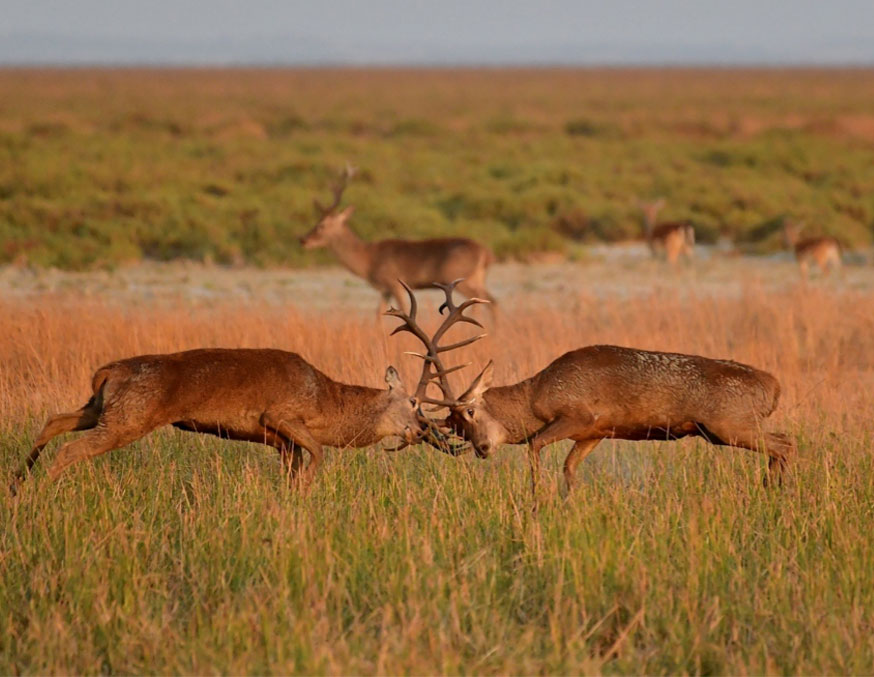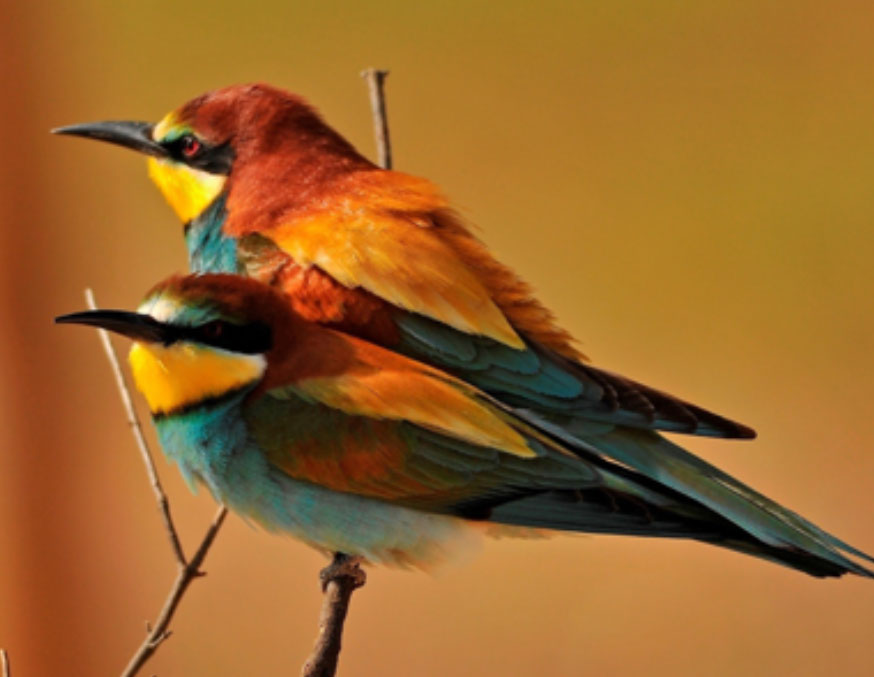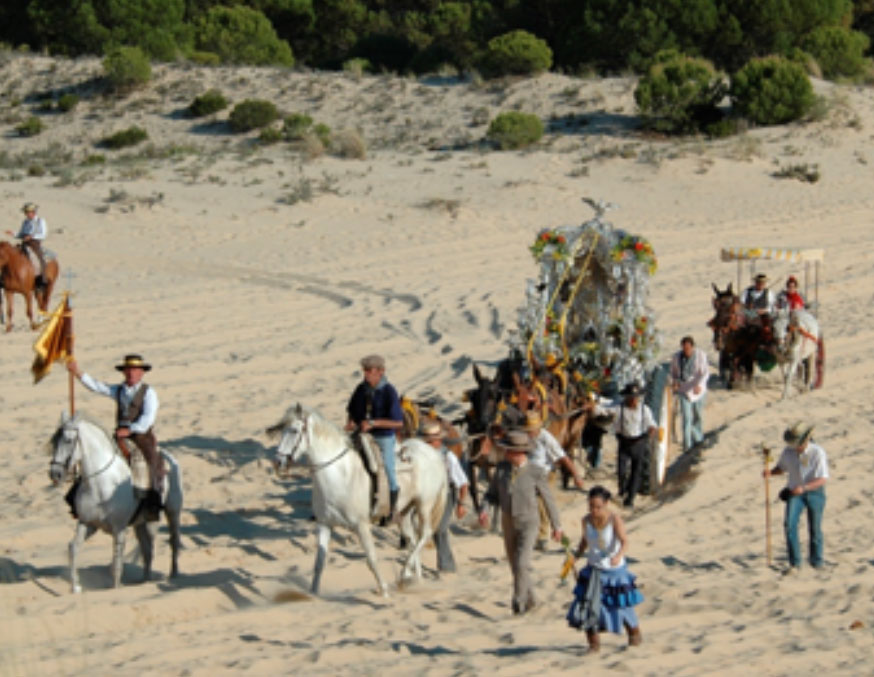

At 28 km long, the beach in Doñana National Park is one of the longest stretches of unspoilt coast-line in Europe, covering around 35 km from Matalascañas to the Guadalquivir estuary. Doñana’s beaches are powerfully dynamic, constantly changing as the centuries go by due to the advancing and retreating seas. The three 16th century beacon towers that are dotted along the coast bear witness to these changes, and today are used as shelter by peregrine falcons.
South-westerly winds ceaselessly transport sand over the National Park’s beaches that is subse-quently moved inland to form successive ridges of mobile dunes.
The beach provides shelter for thousands of coastal birds and the remains of marine species such as crustaceans and fish are washed up here.
Material is normally dragged along by the tides and the rising and falling Guadalquivir and deposited in the contact zone between the high water mark and the embryo dunes. This zone is populated by colonizing plant life that flourishes in an environment of young, unstable sand and salty sea spray. Important species include European searocket (Cakile marítima), coastal bugloss (Equium gaditanum), sea spurge (Euphorbia paralias), sea holly (Eryngium maritimum) and sea daffodil (Pancratium maritimum). These plants share their home with several species of beetle (Pimelia spp.), sand earwigs and the large psammodromus sand lizard.
Typical inhabitants of the beach include large flocks of yellow-legged gulls who mingle with lesser black-backed gulls, Audouin’s gull (until recently quite rare), sandwich terns, little terns and oyster-catchers. It’s also common to spot sanderlings running to and fro between the waves and Kentish plovers a little further inland.
A perhaps surprising fact is that foxes and wild boar have frequently been seen on the beach. Foxes patrol the shore in search of any dead animals that might wash up here, while wild boar often appear when the tide has left clams on the sand, or when reed shoots have been dumped on the beach after a flood or a storm.
This plant, in combination with other factors, helps to create the dunes that are subsequently moved by the wind.
This plant is found in the sand along the coast. It grows in full sunlight, and can successfully withstand prolonged periods of drought.
Flowers from the beginning of spring to the height of summer. Its bouquets of flowers are reminiscent of a coiled snake.
Annual plant that grows in mounds or clumps of sand on beaches and dunes.
Small, busy wader. It lays its eggs on the beach so great care must be taken when cleaning the sand.
Great specialists in prising open shells to feed on the region’s famous wedge clams. You might spot some are whiter than usual.
Pale-coloured bird that continuously follows the to-ing and fro-ing of the waves. Is it looking for something?
This bird would be the ‘Ferrari of the skies’. It usually nests in old beacons and you may pass some on your tour.
When you think of somewhere that has been made a National Park, you imagine somewhere that is a unique enclave with a grand or spectacular landscape. In terms of Doñana, the former is cer-tainly true, but you have to work a little harder to see the latter. Its flatness, aridity at certain times of year and the apparent monotony of its landscapes can make it hard to appreciate its beauty. You could say that it reveals its charms little by little, and only if you take the time to carefully unravel its mysteries and clues, slowly capturing the essence of this nature reserve and the fascinating relationship between its living inhabitants and the physical environment. This is one of Doñana’s main attractions. Let yourself be swept up by it and join the countless other travellers who have been overwhelmed by its magic and its unique and authentic beauty. Sdad. Coop. And. Marismas del Rocío “Doñana Visitas” hopes to share fundamental knowledge about the park with you so that you can appreciate its defining features.

Rutting: one of the most spectacular sights to enjoy in Doñana National Park, this natural phe-nomenon takes place from the middle to the end of August.
When the intense midday heat makes way for an evening breeze, red deer come down from dense thickets to the clearings and pastures of the vera.
Stags bellow their might to the world to draw herds of hinds to their side, jealously defending their family until spring when the hinds give birth to beautiful fawns.

Birds await the long-desired rains that flood the marshland, turn the forests green once more and sate the park’s thirst.
These birds are totally dependent on the level of flooding in this vast water plain for successful breeding; the scale of migration to Doñana is impressive and over 200,000 migratory birds pass through the zone each winter.

Geese arrive in Doñana’s marshland in winter when the cold temperatures in northern Europe freezes the fields where they feed. They are drawn to the gentle winter climate of Huelva’s wet-lands.
Geese feed on sedge roots that grow underwater in the marshes but are hard to digest. To help, the geese swallow sand before feeding; the sand works like sandpaper in their gizzard, making the roots easier to process.
And then the show begins! The break of dawn alerts the geese that it’s time to fly up to the hill that bears their name.

Spring is the moment life returns to Doñana, the days are longer, the temperatures are milder, an-imals awaken after months of lethargy, flowers inundate the landscape with brilliant colours and the sounds of nature fill the air.
In the marshes you can hear Western swamphens grunt while little grebes trill and Eurasian coots squawk in more open waters. Streaked fantail warblers circle the skies above, adding to the scene with their piercing cries.
Flamingos honk, black kites whistle and Imperial eagles give a dry bark as they soar over the pine trees.

This bird starts to appear at the end of March or the beginning of April. They visit in groups of 25-30 birds and are rarely seen travelling solo. Their unmistakeable song is instantly recognised by anyone familiar with it, alerting bird-watchers to scan the skies.
The European bee-eater is definitely one of the most eye-catching birds in these latitudes and pho-tographers and birders enjoy spotting them each year.

Each year, on the weekend of Pentecost Sunday, the village of El Rocío is visited by an immense number of pilgrims who have travelled with their brotherhood on foot, horseback or wagon to pay tribute to the Virgin of El Rocío. The celebration culminates on Sunday to Monday night, the mo-ment of “el salto a la reja” when the procession of the Virgin begins.
El Rocío is the most famous jewel of Doñana, a village with the air of an old settlement by the sea where the waters of the marshlands slowly pool.

This tradition can be traced back to an order issued in 1504 by the Duke of Medina Sidonia and the Asociación Nacional de Criadores de Ganado Marismeño has preserved it until the present day.
La Saca de las Yeguas is, broadly speaking, a farming activity that involves bringing in the marismeño horses that have spent the year grazing and breeding in different areas inside Doñana Nature Reserve and taking them to Almonte for the three-day Livestock Fair.
Once there, in the Huerta de la Cañada enclosure, yegüerizos, specialists in this breed, do the work needed to improve the well-being of these valuable animals, which are unique to the Doñana marshland ecosystem and are in danger of extinction. Once the fair has ended, the animals are returned to their environment where they remain living in freedom until the following year.
